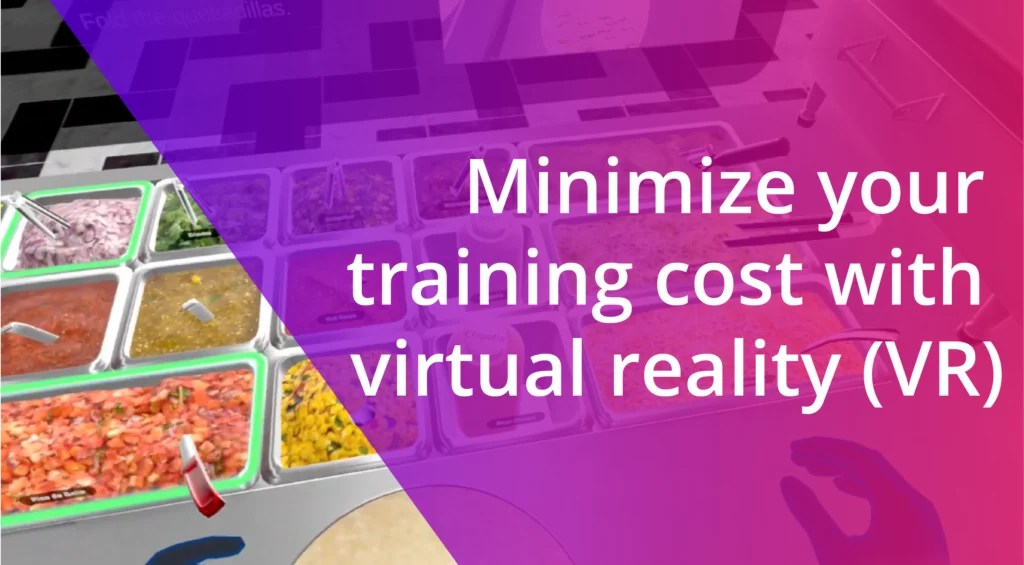Let’s be honest here, training new employees quickly and effectively while minimizing costs has always been a challenge for Quick Service Restaurants (QSR). Virtual Reality (VR) is a game-changing technology that is starting to transform the way QSRs train their staff. In this article, we will explore how VR can drastically reduce training costs, minimize food waste, and improve employee retention, all of which ultimately lead to significant savings for restaurant chains.
1. Reduced Training Time by 75%
One of the most compelling advantages of VR training for QSRs is its ability to significantly cut down on training time. Traditional training methods often involve lengthy theoretical or observation sessions and on-the-job shadowing, which can take weeks or even months for employees to become fully proficient. With VR training, employees can be immersed in realistic simulations that mirror real-world scenarios right from the start.
Imagine a new hire putting on a VR headset and instantly finding themselves behind the counter during a lunchtime rush. While they can learn the different procedures step-by-step, they can also practice taking orders, handling cash, and even dealing with difficult customers in a safe, controlled environment. This accelerated learning process can reduce training time by up to 75%, allowing restaurants to get new hires up to speed much faster.
2. No Food Waste
Traditional training methods often result in food waste. Inexperienced employees may make mistakes in food preparation, leading to wasted ingredients and lost revenue. During store openings, employees need hands-on training and often, the solution is to make food even though nobody will buy it and consume it. VR training eliminates this problem entirely. Virtual food preparation allows trainees to practice without using actual ingredients. They can make mistakes, learn from them, and refine their skills without any real-world consequences. This not only saves money but also ensures consistent food quality.
3. Cost-Effective Development
While the initial setup of VR training can be an investment, it’s important to note that this fee is paid only once. Once the VR training modules are developed and deployed, they can be used for an unlimited number of trainees. This makes VR a viable option for large restaurant chains that are looking to streamline their training processes. The small monthly fee ensure that the software is up to date, as menus or equipment might change over the years. The cost per trainee decreases significantly over time compared to traditional training methods.
4. Improved Employee Retention
VR training doesn’t just save costs in the short term; it also contributes to higher employee retention rates. Employees who undergo VR training are equipped with a better understanding of their job and the required skills right from the start. They build a feeling of confidence and capability, leading to a more positive initial experience in their new role.
Imagine the difference between a new employee who has practiced their tasks in a realistic VR environment and one who has only received theoretical training. The former is likely to feel more prepared and less stressed on their first day, which can result in a higher likelihood of staying with the company. Lower turnover rates mean fewer costs associated with hiring and training replacements.
Linking Benefits to Cost Reduction
The benefits of VR training in QSRs all point towards one undeniable conclusion: cost reduction. By cutting training time, minimizing food waste, and improving employee retention, VR training not only saves money in the short term but also contributes to the long-term success of the restaurant. The initial investment in VR technology is quickly outweighed by the efficiency gains and reduced training expenses.
In conclusion, Quick Service Restaurants that embrace Virtual Reality training are positioning themselves at the forefront of innovation in the industry. They are not only reducing costs but also enhancing the quality of training, resulting in happier employees and satisfied customers. VR is not just a technology; it’s a strategic tool that can revolutionize the way QSRs operate, making them more competitive, efficient, and profitable.
Investing in VR training today is an investment in a brighter, cost-effective future for Quick Service Restaurants. The benefits are clear, and the potential for savings is significant. It’s time for QSRs to take a leap into the virtual world of training and reap the rewards it offers.

